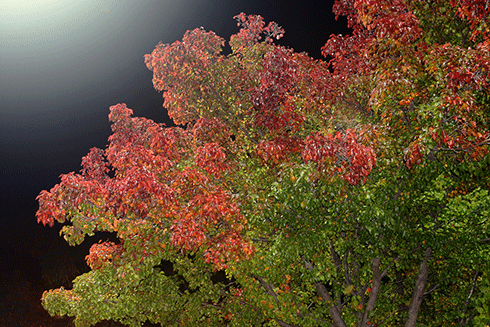
|
Published: 14 January 2015
Vanishing trees could leave cities bereft of wildlife
Urban development often results in the ‘clean up’ of existing trees for construction access, neatness or reducing the risk of damage to surrounding property from falling branches or bushfire. Now researchers are warning that, as the world’s cities lose their large old trees, native wildlife that depend on those trees for food and shelter will also be in jeopardy.

|
|
Street tree in at night, Canberra: the Bush Capital may lose its large old trees over the coming century, leading to loss of remnant native wildlife. Credit:
John/flickr under CC BY-NC-SA 2.0
|
‘Studies based in Canberra – the nation’s Bush Capital – show that Australia could lose 87 per cent of its hollow-bearing trees in the urban landscape over the next 300 years,’ says Darren Le Roux, a PhD student at the ARC Centre of Excellence for Environmental Decisions (CEED) and The Australian National University.
‘Under the worst-case scenario, we could lose all large hollow-bearing trees within the next 115 years,’ he adds.
Iconic urban wildlife, such as parrots and kookaburras, as well as bats, possums, insects and even certain plants may follow the decline of the big trees, says co-researcher Dr Karen Ikin of CEED and ANU.
Mr Le Roux says the loss of old trees, along with other critical habitat structures in urban landscapes, is largely due to ‘tidy-up’ practices driven by negative public attitudes.
‘Large old trees, dead trees and branches, woody debris and shrubs that support native wildlife are often removed because of fears that branches might injure people or damage property, or because structures appear untidy or pose a bushfire risk,’ he says.
‘We are far too quick to remove habitat like large trees without first considering alternative ways to retain these structures that won’t risk people’s lives and property.’
In a recent study (see here for a related study), CEED researchers surveyed 55 bird species across Canberra and found that one-quarter of all species was recorded only at large trees that are typically hundreds of years old. These species include ‘hollow-nesters’, insect- and nectar-eaters and woodland specialists such as mistletoebirds, honeyeaters and superb parrots.
‘While replacing large trees with smaller ones may be suitable for some wildlife, it still puts a wide range of species at risk of decline,’ says Dr Ikin.
‘Small trees simply don’t support the habitat features, provided only by large trees, required by these species to survive over the long-term. It can take more than 200 years for tree hollows to form naturally.
‘Small trees have less peeling bark, dead branches, woody debris, flowers and nectar compared with large established trees. These features may favour anything from fungi and insects to mistletoe, bats, birds and possums. Even ground dwelling animals can benefit from rocks, litter and logs that accumulate under tree canopies.’
To reverse the decline of lold trees, native trees need to remain standing for much longer than currently tolerated in urban areas, and more young trees need to be planted now for the future, Mr Le Roux says.
‘We need many young and medium-sized trees in urban areas because these are the trees that will replace older ones that eventually die in the decades ahead.’
Instead of cutting down large old trees or removing logs, landscaping techniques can be used to separate people and public facilities like footpaths, playgrounds and benches, from these so-called ‘riskier’ structures and ensure the safe retention of vital wildlife habitat.
Surrounding dead trees with rocks, logs, litter and native shrubs can create effective safety barriers and keep maintenance costs associated with weeding and mowing down, he adds.
‘We also need to change public perceptions about big old trees,’ he says. ‘Signs displaying the biodiversity values of large old trees and other key resources in public spaces will go a long way to encourage tolerance, dispel misconceptions and create an awareness and appreciation of the importance of these habitat elements.
‘Large old trees are an irreplaceable part of our natural heritage. Not only are they important biodiversity ‘islands’ in the urban landscape, but they also improve air quality, provide shade and are cultural and aesthetic icons of our cities.
‘The traditional urban green space is dominated by overly manicured garden-style spaces that do not necessarily benefit wildlife. We should re-think this concept and get a bit messier in our parks by retaining some of the resources that are commonly frowned upon.’
‘How we manage our trees now will in turn determine what urban wildlife we’ll still have in the next few hundred years,’ says Dr Ikin. ‘We need to make the right decisions now, because the young trees will take decades to grow, and we're not sure if the animals can survive the long wait.’
Source: CEED



